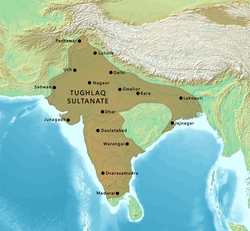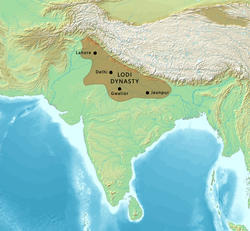Our website is made possible by displaying online advertisements to our visitors.
Please consider supporting us by disabling your ad blocker.
Delhi Sultanate
Sultanate of Delhi | |||||||||||||||||||||||||
|---|---|---|---|---|---|---|---|---|---|---|---|---|---|---|---|---|---|---|---|---|---|---|---|---|---|
| 1206–1526 | |||||||||||||||||||||||||
| Status | Sultanate | ||||||||||||||||||||||||
| Capital | |||||||||||||||||||||||||
| Official languages | |||||||||||||||||||||||||
| Religion | State religion Sunni Islam Others Hinduism (majority), Jainism, Buddhism, Christianity, Zoroastrianism | ||||||||||||||||||||||||
| Government | Monarchy | ||||||||||||||||||||||||
| Sultan | |||||||||||||||||||||||||
• 1206–1210 | Qutb ud-Din Aibak (first) | ||||||||||||||||||||||||
• 1517–1526 | Ibrahim Lodi (last) | ||||||||||||||||||||||||
| Legislature | Corps of Forty (1211–1266) | ||||||||||||||||||||||||
| Historical era | Medieval India | ||||||||||||||||||||||||
| 25 June 1206 | |||||||||||||||||||||||||
| 1 February – 13 June 1290 | |||||||||||||||||||||||||
| 6 September 1320 | |||||||||||||||||||||||||
| 17–20 December 1398 | |||||||||||||||||||||||||
| 21 April 1526 | |||||||||||||||||||||||||
| Area | |||||||||||||||||||||||||
| 1250 | 1,300,000[12] km2 (500,000 sq mi) | ||||||||||||||||||||||||
| 1300 | 1,500,000[13] km2 (580,000 sq mi) | ||||||||||||||||||||||||
| 1312 | 3,200,000[14] km2 (1,200,000 sq mi) | ||||||||||||||||||||||||
| 1350 | 2,800,000[15] km2 (1,100,000 sq mi) | ||||||||||||||||||||||||
| Population | |||||||||||||||||||||||||
• 1500 estimate | 101,000,000[16] | ||||||||||||||||||||||||
| Currency | Taka | ||||||||||||||||||||||||
| |||||||||||||||||||||||||
| Today part of | |||||||||||||||||||||||||
The Delhi Sultanate or the Sultanate of Delhi was a late medieval empire primarily based in Delhi that stretched over large parts of the Indian subcontinent for more than three centuries.[17][18][19] The sultanate was established around c. 1206–1211 in the former Ghurid territories in India. The sultanate's history is generally divided into five periods: Mamluk (1206–1290), Khalji (1290–1320), Tughlaq (1320–1414), Sayyid (1414–1451), and Lodi (1451–1526). It covered large swaths of territory in modern-day India, Pakistan, Bangladesh, as well as some parts of southern Nepal.[20]
The foundation of the Sultanate was established by the Ghurid conqueror Muhammad Ghori, who routed the Rajput Confederacy, led by Ajmer ruler Prithviraj Chauhan, in 1192 near Tarain in a reversal of an earlier battle.[21] As a successor to the Ghurid dynasty, the Delhi Sultanate was originally one of several principalities ruled by the Turkic slave-generals of Muhammad Ghori, including Taj al-Din Yildiz, Qutb ud-Din Aibak, Bahauddin Tughril and Nasir ad-Din Qabacha, that had inherited and divided the Ghurid territories amongst themselves.[22] Khalji and Tughlaq rule ushered a new wave of rapid and continual Muslim conquests deep into South India.[23][24][25] The sultanate finally reached the peak of its geographical reach during the Tughlaq dynasty, occupying most of the Indian subcontinent under Muhammad bin Tughluq. A major political transformation occurred across North India, triggered by the Central Asian king Timur's devastating raid on Delhi in 1398, followed soon afterwards by the re-emergence of rival Hindu powers such as Vijayanagara Empire and Kingdom of Mewar asserting independence, and new Muslim sultanates such as the Bengal and Bahmani Sultanates breaking off.[26][27] In 1526, Timurid ruler Babur invaded northern India and conquered the Sultanate, leading to its succession by the Mughal Empire.
The establishment of the Sultanate drew the Indian subcontinent more closely into international and multicultural Islamic social and economic networks,[28] as seen concretely in the development of the Hindustani language[29] and Indo-Islamic architecture.[30][31] It was also one of the few powers to repel attacks by the Mongols (from the Chagatai Khanate)[32] and saw the enthronement of one of the few female rulers in Islamic history, Razia Sultana, who reigned from 1236 to 1240.[33] During the sultanate's rule, there was no mass forcible conversion of Hindus, Buddhists, and other dharmic faiths, and Hindu officials and vassals were readily accepted.[34] However, there were cases like Bakhtiyar Khalji's annexations, which involved a large-scale desecration of Hindu and Buddhist temples and the destruction of universities and libraries.[35][34][36][37][38] Mongolian raids on West and Central Asia set the scene for centuries of migration of fleeing soldiers, intelligentsia, mystics, traders, artists, and artisans from those regions into the subcontinent, thereby establishing Islamic culture there.[39][40]
- ^ Grey flag with black vertical stripe according to the Catalan Atlas (c. 1375):
 in the depiction of the Delhi Sultanate in the Catalan Atlas
in the depiction of the Delhi Sultanate in the Catalan Atlas
- ^ Kadoi, Yuka (2010). "On the Timurid flag". Beiträge zur islamischen Kunst und Archäologie. 2: 148. doi:10.29091/9783954909537/009. S2CID 263250872.
...helps identify another curious flag found in northern India – a brown or originally silver flag with a vertical black line – as the flag of the Delhi Sultanate (602–962/1206–1555).
- ^ Note: other sources describe the use of two flags: the black Abbasid flag, and the red Ghurid flag, as well as various banners with figures of the new moon, a dragon or a lion.Qurashi, Ishtiyaq Hussian (1942). The Administration of the Sultanate of Delhi. Kashmiri Bazar Lahore: SH. MUHAMMAD ASHRAF. p. 143.
Large banners were carried with the army. In the beginning, the sultans had only two colours : on the right were black flags, of Abbasid colour; and on the left, they carried their colour, red, which was derived from Ghor. Qutb-ud-din Aibak's standards bore the figures of the new moon, a dragon or a lion; Firuz Shah's flags also displayed a dragon.
Jha, Sadan (8 January 2016). Reverence, Resistance and Politics of Seeing the Indian National Flag. Cambridge University Press. p. 36. ISBN 978-1-107-11887-4., also "On the right of the Sultan was carried the black standard of the Abbasids and on the left the red standard of Ghor." in Thapliyal, Uma Prasad (1938). The Dhvaja, Standards and Flags of India: A Study. B.R. Publishing Corporation. p. 94. ISBN 978-81-7018-092-0. - ^ a b c Schwartzberg 1978, p. 147, map XIV.3 (h).
- ^ Jackson 2003.
- ^ Schwartzberg 1978, pp. 39, 148.
- ^ For a map of their territory see: Schwartzberg 1978, p. 147, map XIV.4 (d)
- ^ Eaton, Richard Maxwell (2015). The Sufis of Bijapur, 1300–1700: Social Roles of Sufis in Medieval India. Princeton University Press. pp. 41–42. ISBN 978-1-4008-6815-5.
- ^ Alam, Muzaffar (1998). "The pursuit of Persian: Language in Mughal Politics". Modern Asian Studies. 32 (2). Cambridge University Press: 317–349. doi:10.1017/s0026749x98002947. S2CID 146630389.
Hindavi was recognized as a semi-official language by the Sor Sultans (1540–1555) and their chancellery rescripts bore transcriptions in the Devanagari script of the Persian contents. The practice is said to have been introduced by the Lodis (1451–1526).
- ^ "Arabic and Persian Epigraphical Studies - Archaeological Survey of India". Asi.nic.in. Archived from the original on 29 September 2011. Retrieved 29 January 2018.
- ^ Jackson 2003, p. 28.
- ^ Size and Duration of Empires: Systematics of Size "[1]
- ^ Size and Duration of Empires: Systematics of Size "[2]
- ^ Turchin, Peter; Adams, Jonathan M.; Hall, Thomas D. (December 2006). "East-West Orientation of Historical Empires Archived 17 May 2016 at the Portuguese Web Archive" (PDF). Journal of World-Systems Research. 12 (2): 222–223. ISSN 1076-156X. Archived (PDF) from the original on 7 July 2020. Retrieved 7 July 2020.
- ^ Size and Duration of Empires: Systematics of Size "[3]
- ^ Cite error: The named reference
ggdc.netwas invoked but never defined (see the help page). - ^ Shally-Jensen, Michael; Vivian, Anthony (2022). A Cultural Encyclopedia of Lost Cities and Civilizations. ABC-CLIO. p. 171. ISBN 978-1-4408-7311-9.
- ^ Delhi Sultanate, Encyclopædia Britannica
- ^ A. Schimmel, Islam in the Indian Subcontinent, Leiden, 1980
- ^ Chapman, Graham (2016) [1990]. "Religious vs. regional determinism: India, Pakistan and Bangladesh as inheritors of empire". In Chisholm, Michael; Smith, David M. (eds.). Shared Space: Divided Space: Essays on Conflict and Territorial Organization. Routledge. pp. 106–134. ISBN 978-1-317-35837-4.
- ^ Sugata Bose; Ayesha Jalal (2004). Modern South Asia: History, Culture, Political Economy. Psychology Press. p. 21. ISBN 978-0-415-30786-4.
It was a similar combination of political and economic imperatives which led Muhammad Ghuri, a Turk, to invade India a century and half later, in 1192. His defeat of Prithviraj Chauhan, a Rajput chieftain, in the strategic battle of Tarain in northern India paved the way for the establishment of the first Muslim sultanate...
- ^ K. A. Nizami (1992). A Comprehensive History of India: The Delhi Sultanat (A.D. 1206–1526). Vol. 5 (2nd ed.). The Indian History Congress / People's Publishing House. p. 198.
- ^ Mahajan (2007). History of Medieval India. Chand. p. 121. ISBN 9788121903646.
- ^ Sugata Bose, Ayesha Jalal (1998). Modern South Asia: History, Culture, Political Economy. Psychology Press. p. 28. ISBN 9780415169523.
- ^ M.S. Ahluwalia (1999). "Rajput Muslim Relations (1200–1526 A.D.)". In Shyam Singh Ratnawat; Krishna Gopal Sharma (eds.). History and Culture of Rajasthan (From Earliest Times upto 1956 A.D.). Centre for Rajasthan Studies, University of Rajasthan. p. 135. OCLC 264960720.
The Khaiji rule proved much stronger for the Rajput principalities ... A new wave of invasions and conquests began, which ended only when practically the whole of India had been bought under the sway of the Delhi kingdom.
- ^ Hermann Kulke and Dietmar Rothermund, A History of India, 3rd ed., Routledge, 1998, ISBN 0-415-15482-0, pp. 187–190.
- ^ Smith 1920, Ch. 2, p. 218.
- ^ Asher & Talbot 2008, pp. 50–52.
- ^ Cite error: The named reference
brown2008was invoked but never defined (see the help page). - ^ A. Welch, "Architectural Patronage and the Past: The Tughluq Sultans of India", Muqarnas 10, 1993, Brill Publishers, pp. 311–322.
- ^ J. A. Page, Guide to the Qutb, Delhi, Calcutta, 1927, pp. 2–7.
- ^ Pradeep Barua The State at War in South Asia, ISBN 978-0803213449, pp. 29–30.
- ^ Bowering et al., The Princeton Encyclopedia of Islamic Political Thought, ISBN 978-0691134840, Princeton University Press
- ^ a b "Delhi sultanate | History, Significance, Map, & Rulers | Britannica". www.britannica.com. 17 November 2023. Retrieved 31 December 2023.
The Delhi sultanate made no break with the political traditions of the later Hindu period—namely, that rulers sought paramountcy rather than sovereignty. It never reduced Hindu chiefs to unarmed impotence or established an exclusive claim to allegiance. The sultan was served by a heterogeneous elite of Turks, Afghans, Khaljīs, and Hindu converts; he readily accepted Hindu officials and Hindu vassals. Threatened for long periods with Mongol invasion from the northwest and hampered by indifferent communications, the Delhi sultans perforce left a large discretion to their local governors and officials.
- ^ Gul and Khan (2008)"Growth and Development of Oriental Libraries in India", Library Philosophy and Practice, University of Nebraska–Lincoln
- ^ Richard Eaton, Temple Desecration and Muslim States in Medieval India at Google Books, (2004)
- ^ Richard Eaton (September 2000). "Temple Desecration and Indo-Muslim States". Journal of Islamic Studies. 11 (3): 283–319. doi:10.1093/jis/11.3.283.
- ^ Jackson, Peter (2000). The Delhi Sultanate: a political and military history. Cambridge studies in Islamic civilization (Reprint ed.). Cambridge: Cambridge University Press. ISBN 978-0-521-54329-3.
- ^ Ludden 2002, p. 67.
- ^ Asher & Talbot 2008, pp. 50–51.
Previous Page Next Page








